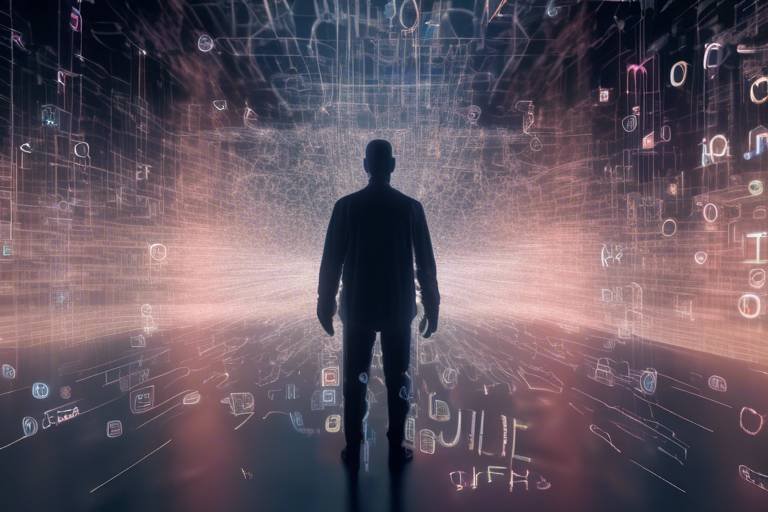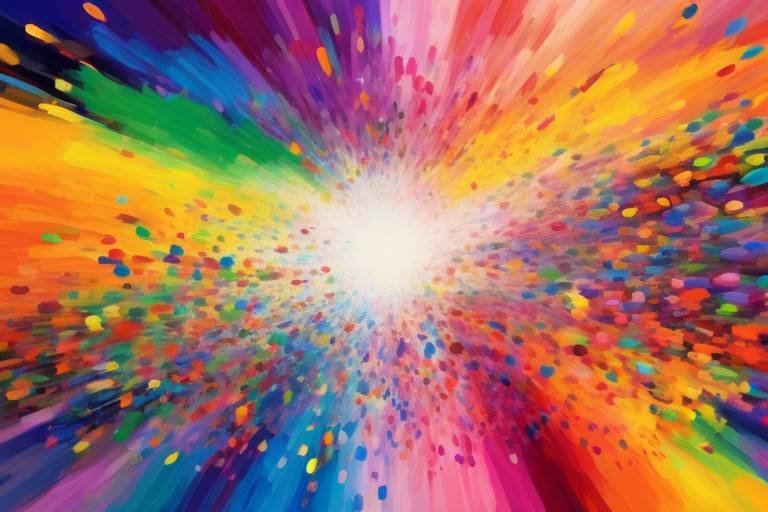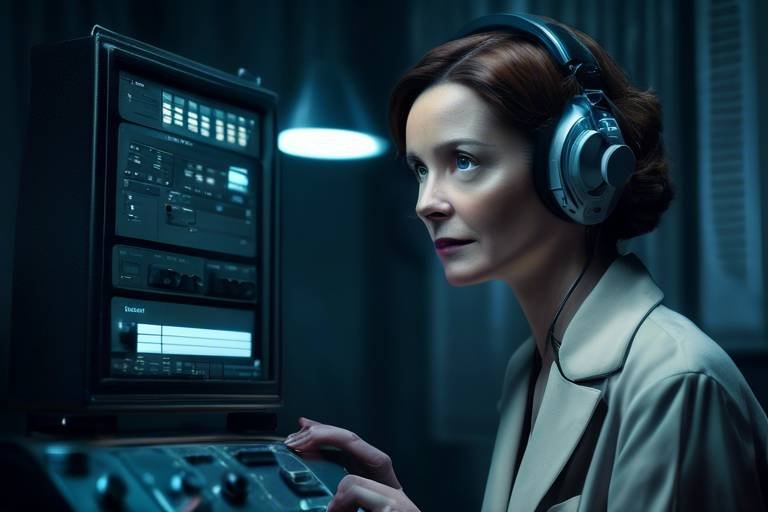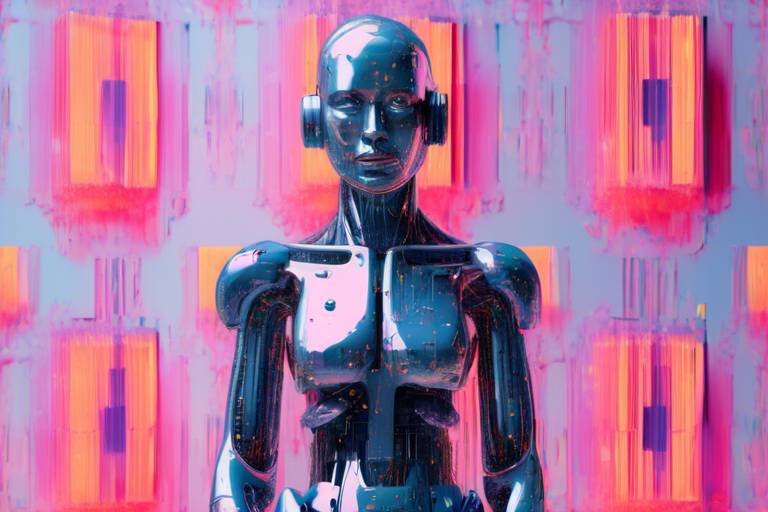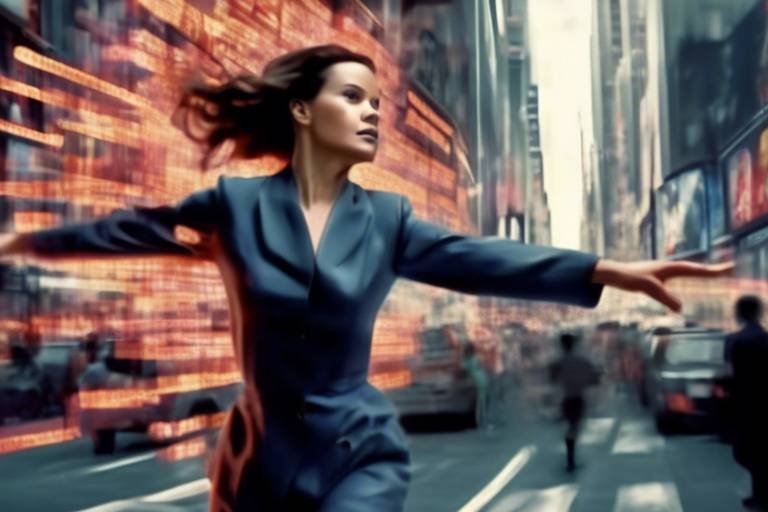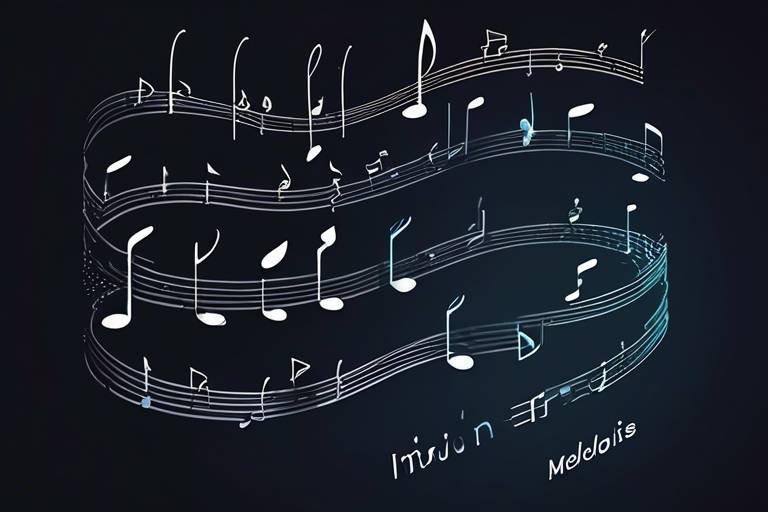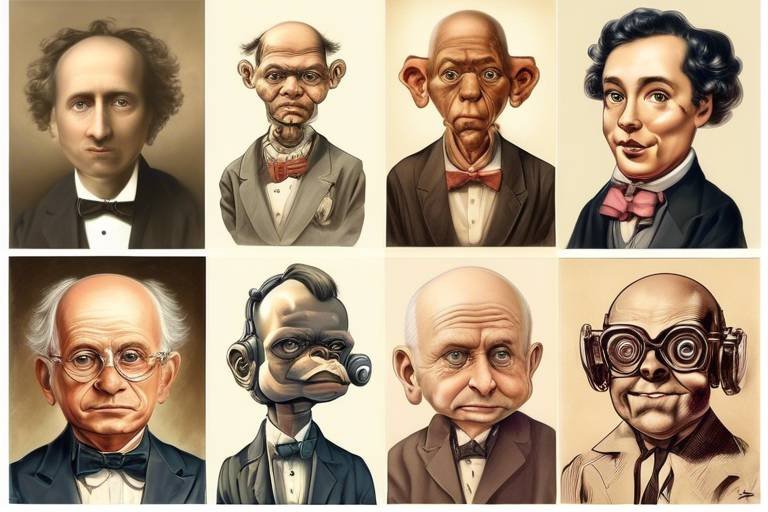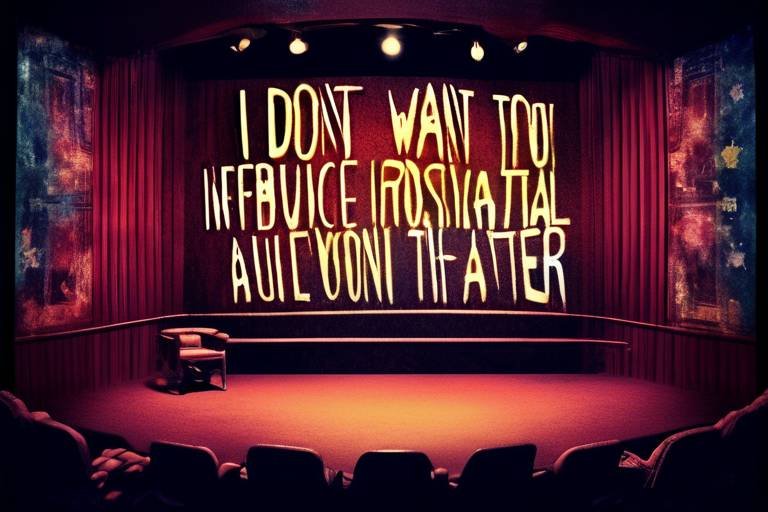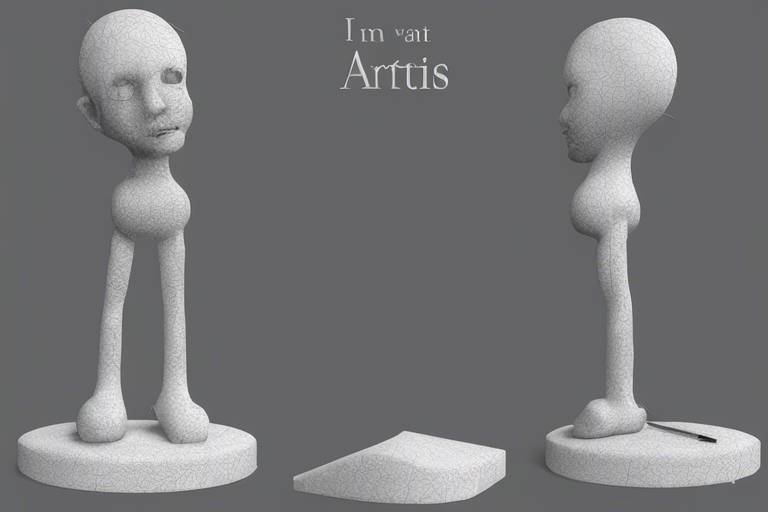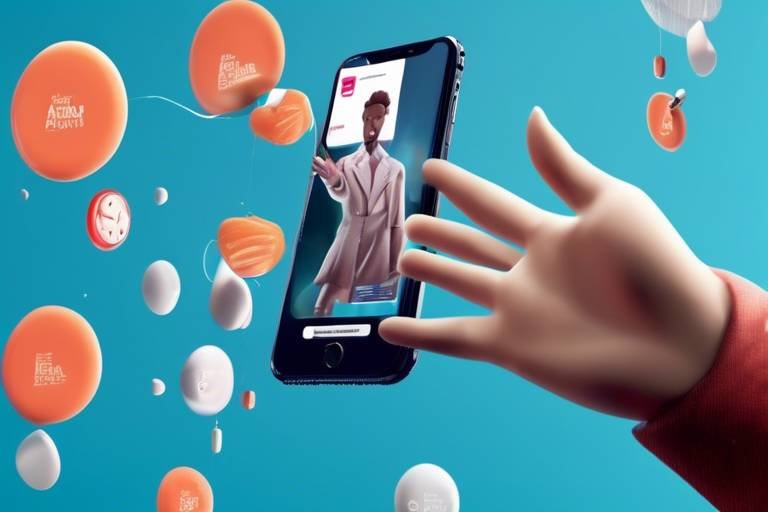Harnessing AI for Enhanced Animation Effects
In today's fast-paced digital landscape, animation has become a vital part of storytelling across various media. Whether it's in films, video games, or online content, the demand for high-quality animations is ever-increasing. Enter artificial intelligence (AI), a game-changer that's revolutionizing the animation industry. With its ability to automate tedious tasks and enhance creative processes, AI is not just a tool; it’s an essential partner for animators looking to push the boundaries of what’s possible.
Imagine a world where animators can focus solely on their creativity, leaving the repetitive and time-consuming tasks to AI. This is no longer a distant dream but a reality that many animation studios are embracing. By leveraging AI technologies, artists can create stunning visuals more efficiently, allowing them to tell their stories with greater impact. From automating in-betweening to enhancing visual effects, AI is reshaping the animation landscape in profound ways.
As we delve deeper into the role of AI in animation, it becomes clear that this technology is not just about speeding up the production process. It’s about enhancing the quality of animations, making them more engaging and relatable. With AI’s ability to analyze data and learn from it, animators can gain insights into audience preferences, ensuring that their creations resonate with viewers. In this article, we will explore the various ways AI is transforming animation, the tools that are emerging, and the future trends that promise to reshape the industry.
So, buckle up as we take you on a journey through the exciting world of AI-enhanced animation effects. Whether you are an aspiring animator, a seasoned professional, or simply a fan of animated content, there’s something here for everyone.
AI technologies are transforming animation by automating repetitive tasks, improving character animation, and enhancing visual effects, allowing artists to focus on creativity and storytelling. In the past, animators spent countless hours on tasks like in-betweening, where they filled in the frames between key poses. However, with the advent of AI, these tasks can now be handled with remarkable efficiency. AI algorithms can analyze motion data and generate in-between frames, freeing up animators to concentrate on the more artistic aspects of their work.
Moreover, AI is making strides in character animation. Imagine characters that move with a level of realism that captivates audiences. Machine learning algorithms can learn from vast datasets of human motion, enabling more fluid and believable animations. This not only enhances the viewing experience but also deepens the emotional connection between the audience and the characters. It’s akin to watching a great actor bring a character to life on screen—every movement, every expression feels genuine.
Numerous AI-based tools are emerging in the animation industry, enabling artists to create stunning visuals more efficiently. These tools help streamline workflows and enhance the quality of animations. For instance, software that utilizes AI can assist in tasks like lip-syncing, where the software analyzes audio and automatically generates corresponding mouth movements. This not only saves time but also ensures that the animation aligns perfectly with the dialogue.
Machine learning algorithms analyze vast datasets to improve animation techniques, enabling more realistic movements and expressions in characters, thus enhancing viewer engagement. These algorithms work by identifying patterns in motion and behavior, allowing animators to create characters that respond more naturally to their environments. It’s like having a virtual assistant that not only understands your needs but also anticipates them, making the animation process smoother and more intuitive.
Deep learning models are employed to create lifelike animations by understanding and replicating human behaviors, resulting in more relatable and immersive characters. This technology allows animators to create characters that not only look real but also behave in a way that feels authentic. The result? Audiences are drawn into the story, feeling a genuine connection with the characters on screen.
AI can analyze audience preferences and trends, providing animators with valuable insights that guide the creative process and help tailor animations to target demographics. By understanding what resonates with viewers, animators can craft stories that are not only visually stunning but also emotionally impactful.
AI technologies can automate various animation processes, such as in-betweening and lip-syncing, significantly reducing production time and allowing animators to focus on more complex tasks. This automation leads to faster turnaround times and the ability to produce more content without sacrificing quality. Imagine being able to release animations at a pace that keeps your audience engaged and eagerly awaiting your next creation!
Artificial intelligence is pushing the boundaries of visual effects, enabling the creation of stunning, high-quality visuals that captivate audiences and elevate storytelling in animation. With AI, animators can create intricate effects that were once thought to be impossible, allowing for a new level of creativity and imagination.
Procedural generation, powered by AI, allows animators to create complex environments and effects dynamically, leading to more diverse and immersive animation experiences. This technique can be compared to a chef who can whip up a gourmet meal from whatever ingredients are available, resulting in unique dishes every time. Similarly, AI can generate endless variations of backgrounds, characters, and effects, making each animation a fresh experience.
AI-enhanced real-time rendering techniques enable animators to visualize their work instantly, facilitating faster iterations and adjustments, ultimately improving the overall production quality. This means that animators can see how their changes affect the final product in real-time, allowing for a more fluid and responsive creative process.
As AI continues to evolve, its integration into animation will deepen, leading to innovative storytelling methods and unprecedented creative possibilities for animators and audiences alike. We are on the brink of a new era in animation, where AI will not only assist in production but also inspire new forms of storytelling that we have yet to imagine.
- What is AI in animation? AI in animation refers to the use of artificial intelligence technologies to automate tasks, enhance visual effects, and improve character animation, allowing animators to focus on creativity.
- How does AI improve the animation process? AI improves the animation process by automating repetitive tasks, providing data-driven insights, and enhancing the realism of character movements and expressions.
- What are some popular AI animation tools? Some popular AI animation tools include Adobe Character Animator, Blender with AI plugins, and various machine learning frameworks designed for animation.
- Is AI going to replace animators? No, AI is designed to assist animators, not replace them. It enables them to focus on more creative aspects of their work while handling repetitive tasks.

The Role of AI in Animation
Artificial Intelligence (AI) is not just a buzzword; it's a game changer in the world of animation. Imagine a world where animators can focus more on their creative visions rather than getting bogged down by repetitive tasks. That's the magic AI brings to the table. By automating mundane processes, AI allows artists to channel their energy into storytelling and character development, making animations not just visually appealing but also emotionally resonant.
One of the most significant impacts of AI in animation is its ability to improve character animation. Traditionally, animators spent countless hours perfecting movements and expressions to make characters feel alive. With AI-driven tools, these processes are streamlined. For instance, AI can analyze motion capture data and apply it to digital characters, resulting in movements that are both fluid and realistic. This technology not only enhances the quality of animations but also saves precious time in the production cycle.
Moreover, AI plays a crucial role in enhancing visual effects. It can simulate complex physical phenomena, like smoke, fire, or water, with astonishing realism. This means animators can create breathtaking scenes that captivate audiences without spending weeks on intricate details. As a result, the storytelling aspect of animation becomes even richer, as stunning visuals can convey emotions and narratives in ways that words alone cannot.
In addition to automation and visual enhancement, AI provides valuable insights into audience preferences. By analyzing data from various sources, AI can identify trends and patterns that inform the creative process. For example, if a particular animation style or character design is gaining popularity, animators can adapt their projects accordingly. This data-driven approach not only increases the chances of success but also fosters a deeper connection between the audience and the content.
In summary, the role of AI in animation is multifaceted and transformative. It empowers artists by automating tedious tasks, improving character realism, and offering insights into audience preferences. As we move forward, the synergy between AI and animation will undoubtedly lead to even more innovative storytelling methods and enhanced viewer experiences.

AI-Driven Animation Tools
In the rapidly evolving world of animation, are becoming the backbone of creativity, efficiency, and innovation. These tools are not just enhancing the quality of animations but are also streamlining the entire production process. Imagine having a virtual assistant that can handle tedious tasks while you focus on crafting the next big story—this is precisely what AI tools offer to animators today.
One of the most exciting aspects of these tools is their ability to automate repetitive tasks. For instance, traditional animation often requires animators to create hundreds of frames for a single scene, but with AI, this process can be significantly expedited. Tools equipped with machine learning algorithms can analyze existing frames and generate in-between frames automatically, a process known as in-betweening. This not only saves time but also allows animators to maintain a consistent style throughout their work.
Moreover, AI-driven tools are enhancing character animation in ways that were previously unimaginable. By utilizing advanced algorithms, these tools can create more fluid and realistic movements, making characters feel alive. For example, when animators use AI to analyze motion capture data, they can replicate human movements with incredible accuracy, ensuring that every jump, twist, and turn resonates with the audience. This capability leads to a more immersive viewing experience, as the audience can connect with the characters on a deeper level.
Another remarkable feature of AI animation tools is their ability to provide data-driven insights. By analyzing audience preferences and trends, these tools can guide animators in tailoring their content to meet the expectations of their target demographics. This means that instead of relying solely on intuition, animators can make informed decisions based on real-time data, resulting in animations that are not only visually stunning but also highly engaging.
To illustrate the impact of these tools, let's look at a table that highlights some of the leading AI-driven animation tools currently making waves in the industry:
| Tool Name | Key Features | Target Users |
|---|---|---|
| Adobe Character Animator | Real-time animation, motion capture, lip-syncing | Professional animators, studios |
| Toon Boom Harmony | Vector-based animation, 2D rigging, AI-assisted in-betweening | 2D animators, educational institutions |
| DeepMotion | AI-driven motion capture, character rigging | Game developers, indie animators |
| Runway ML | Generative design, video editing, style transfer | Content creators, filmmakers |
As we can see, these tools cater to various aspects of animation, from character rigging to motion capture, making the animation process not only faster but also more accessible to a wider range of creators. Whether you are a seasoned professional or just starting your journey in animation, leveraging these AI-driven tools can significantly enhance your workflow and creative output.
In conclusion, the rise of AI-driven animation tools marks a transformative shift in the animation industry. By automating mundane tasks and providing valuable insights, these tools empower animators to unleash their creativity and tell stories that resonate with audiences around the globe. The future of animation is here, and it is powered by AI.
- What are AI-driven animation tools?
AI-driven animation tools are software applications that utilize artificial intelligence to automate tasks, enhance character movements, and provide data-driven insights to animators. - How do these tools improve efficiency in animation?
By automating repetitive tasks such as in-betweening and lip-syncing, AI tools allow animators to focus on more complex and creative aspects of their work, ultimately speeding up the production process. - Can AI tools create animations from scratch?
While AI tools can assist in generating animations, they are designed to complement human creativity rather than replace it. Animators still play a crucial role in the storytelling process. - Are AI animation tools suitable for beginners?
Yes, many AI-driven tools are user-friendly and designed to help beginners learn the basics of animation while providing advanced features for seasoned professionals.

Machine Learning Algorithms
Machine learning algorithms are at the forefront of revolutionizing the animation industry, acting as the secret sauce that enhances the way animators create and refine their work. Imagine a world where painstakingly animating every single frame is a thing of the past. With machine learning, this dream is becoming a reality! By analyzing vast datasets, these algorithms can learn patterns and improve animation techniques, resulting in movements and expressions that feel incredibly realistic.
One of the most exciting aspects of machine learning in animation is its ability to enhance character animations. For instance, when animators input basic movements, machine learning algorithms can predict and generate fluid transitions, making characters come to life in ways that were previously impossible. This not only saves time but also allows artists to focus on storytelling and creative aspects rather than getting bogged down in technical details.
To give you a clearer picture, let’s look at some key benefits of machine learning algorithms in animation:
- Improved Realism: By analyzing how humans move and express emotions, these algorithms can replicate realistic gestures and facial expressions, making characters more relatable.
- Enhanced Engagement: With lifelike animations, viewers are more likely to connect with the characters on screen, leading to a more immersive experience.
- Efficiency Boost: Automating routine tasks allows animators to dedicate more time to complex scenes that require their unique artistic touch.
Moreover, machine learning algorithms can also be trained to detect and correct flaws in animations. For example, if a character's walk cycle looks unnatural, the algorithm can suggest adjustments based on what it has learned from analyzing thousands of walk cycles across various animations. This feedback loop not only enhances the quality of the animation but also accelerates the production process.
As we look to the future, the potential of machine learning in animation is boundless. With ongoing advancements in technology, we can expect even more sophisticated algorithms that will push the limits of creativity. The intersection of AI and animation is not just a trend; it's the dawn of a new era in visual storytelling that promises to captivate audiences like never before.
- What is machine learning in animation? Machine learning in animation refers to the use of algorithms that analyze data to enhance animation techniques, making movements and expressions more realistic.
- How does machine learning improve character animations? By learning from vast datasets of human movements, machine learning algorithms can generate more fluid and natural animations, enhancing viewer engagement.
- Can machine learning algorithms automate tasks in animation? Yes, these algorithms can automate repetitive tasks such as in-betweening and lip-syncing, allowing animators to focus on more complex creative work.

Deep Learning for Realism
Deep learning is the magic wand that animators have been waiting for, transforming the way characters are brought to life on screen. Imagine a world where animated characters don’t just move; they feel and express emotions just like real humans. This is the power of deep learning, where sophisticated algorithms analyze vast amounts of data to replicate human behaviors and reactions with astonishing accuracy. By understanding the nuances of facial expressions and body language, these models create animations that resonate with audiences on a deeper level.
One of the most exciting aspects of deep learning in animation is its ability to generate lifelike movements. For instance, when animators use deep learning techniques, they can input a range of data about how a character should move or react in various scenarios. The AI then processes this information, learning from real-life examples to produce animations that are not only fluid but also believable. Think of it like teaching a child to mimic your actions; the more they observe, the better they become at imitating you. Similarly, the more data the AI processes, the more realistic the animations become.
But how does this work in practice? Well, deep learning models use a technique called neural networks to analyze and learn patterns in data. These networks consist of layers of interconnected nodes that process information, much like how our brains function. By training these networks on large datasets of human movements, animators can create characters that exhibit a wide range of emotions and reactions. This not only enhances viewer engagement but also makes the storytelling more compelling. Audiences can relate to characters who display genuine emotions, making the entire experience more immersive.
Moreover, deep learning doesn't just stop at character movements. It extends to the entire animation pipeline, influencing aspects like lighting and environmental interactions. For example, when a character interacts with their surroundings, deep learning can help simulate realistic shadows and reflections, further enhancing the visual experience. This level of detail ensures that every frame is not just a picture but a vibrant scene that tells a story. The result? Animations that are not just seen but felt.
As we look to the future, the integration of deep learning in animation is set to revolutionize the industry. With ongoing advancements, we can expect to see even more sophisticated AI models that push the boundaries of what’s possible. In fact, the potential for deep learning to create interactive animations—where characters respond in real-time to audience reactions—could redefine the way stories are told. Imagine watching a movie where the protagonist adjusts their behavior based on your reactions. That’s not just animation; that’s a whole new level of storytelling!
In conclusion, deep learning is not merely a tool; it’s a transformative force in the animation industry. By enabling the creation of realistic movements and emotional depth in characters, it enhances the overall storytelling experience, making animations more relatable and engaging. As technology continues to evolve, the possibilities for deep learning in animation are virtually limitless, paving the way for a future where animated stories are as rich and complex as the human experience itself.
- What is deep learning in animation?
Deep learning in animation refers to the use of advanced algorithms and neural networks to create realistic character movements and expressions by analyzing vast datasets of human behavior. - How does deep learning enhance storytelling in animation?
By enabling characters to exhibit genuine emotions and realistic movements, deep learning makes animations more relatable, thus enhancing the overall storytelling experience. - Can deep learning be used for real-time animations?
Yes! With advancements in AI, deep learning has the potential to create interactive animations that respond to audience reactions in real-time.

Data-Driven Insights
In the fast-paced world of animation, understanding your audience is crucial. This is where come into play. By leveraging AI, animators can tap into a goldmine of information that reveals audience preferences, behaviors, and trends. Imagine having a crystal ball that shows you what your viewers love the most! With AI, this is becoming a reality.
AI algorithms sift through massive datasets, analyzing everything from viewer engagement metrics to social media interactions. This data helps animators make informed decisions about the themes, styles, and characters that resonate most with their target demographics. For instance, if analytics show that animated characters with relatable backstories garner more attention, animators can focus on developing richer narratives that connect with audiences on a deeper level.
Furthermore, AI can identify emerging trends in real-time, allowing creators to adapt their work accordingly. This means that animators are no longer flying blind; they can pivot their storytelling strategies based on what’s currently captivating viewers. It’s like having a personal assistant who whispers the latest trends in your ear, ensuring you never miss a beat!
To illustrate the impact of data-driven insights, consider the following table:
| Data Type | Insight Gained | Actionable Outcome |
|---|---|---|
| Viewer Engagement Metrics | Identifies popular scenes and characters | Focus on similar character designs and story arcs |
| Social Media Trends | Highlights what themes are trending | Incorporate trending themes into upcoming projects |
| Demographic Preferences | Reveals age and interests of the audience | Create targeted content that appeals to specific age groups |
This table underscores how different types of data can lead to actionable insights, ultimately enhancing the animation process. The beauty of this approach lies in its ability to create a feedback loop where animators can continuously refine their craft based on real-world reactions.
In conclusion, data-driven insights powered by AI are not just a luxury; they are becoming a necessity in the animation industry. By embracing these insights, animators can create more engaging, relevant, and impactful stories that resonate with audiences, paving the way for a new era of animated storytelling.
- How does AI improve animation quality? AI enhances animation quality by automating repetitive tasks and providing tools that help create more realistic movements and expressions.
- What are some popular AI tools for animators? Some popular AI tools include Adobe Character Animator, DeepMotion, and Runway ML, which assist in various animation processes.
- Can AI predict audience preferences? Yes, AI can analyze viewer data to predict preferences, helping animators tailor their content to what audiences are likely to enjoy.
- Is AI taking jobs away from animators? While AI automates certain tasks, it also allows animators to focus on more creative aspects, enhancing their roles rather than replacing them.

Automating Animation Processes
In the fast-paced world of animation, time is often of the essence. With the increasing demand for high-quality content, animators are constantly seeking ways to streamline their workflows. This is where artificial intelligence steps in, revolutionizing the animation process by automating various tasks that once consumed countless hours of manual labor. Imagine being able to focus on the creative aspects of your work while AI handles the repetitive, time-consuming chores. Sounds like a dream, right? Well, it's becoming a reality!
One of the most significant advancements in this area is the automation of in-betweening, which refers to the process of generating intermediate frames between two keyframes. Traditionally, animators had to painstakingly create these frames by hand, a task that could take days or even weeks. Now, AI algorithms can analyze the keyframes and generate smooth transitions in a matter of seconds. This not only saves time but also allows animators to experiment with more dynamic movements and expressions.
Another area where automation shines is in lip-syncing. Matching a character's mouth movements to dialogue is crucial for creating believable animations. With AI, animators can upload audio files, and the software will automatically synchronize the character's lip movements to the spoken words. This technology uses advanced machine learning techniques to analyze phonemes and predict how a character's mouth should move, resulting in a more natural and engaging performance.
Furthermore, AI can assist in the automation of background generation and scene composition. By utilizing procedural generation techniques, animators can create complex environments without the need for manual input at every stage. This means that entire landscapes can be generated based on a few parameters set by the animator, allowing for a more diverse range of settings without the associated labor. For instance, an animator could specify the type of environment—like a forest or a cityscape—and the AI would generate all the necessary elements, from trees to buildings, in a cohesive manner.
Here's a quick overview of some key benefits of automating animation processes with AI:
- Increased Efficiency: By automating repetitive tasks, animators can focus on more creative aspects of their work.
- Consistency: AI ensures that animations maintain a consistent quality and style throughout the production process.
- Faster Turnaround: The speed of automation significantly reduces production time, allowing for quicker project completion.
- Enhanced Creativity: With less time spent on mundane tasks, animators can explore new ideas and push creative boundaries.
In summary, the automation of animation processes through AI is not just a trend—it's a fundamental shift that is reshaping the industry. By embracing these technologies, animators can enhance their productivity, improve the quality of their work, and ultimately create more engaging and visually stunning stories. As we look to the future, it’s clear that the integration of AI in animation will continue to evolve, offering even more tools and techniques that empower artists to bring their visions to life.
Q: What is in-betweening in animation?
A: In-betweening refers to the process of creating intermediate frames between two keyframes to create smooth transitions in animation.
Q: How does AI improve lip-syncing?
A: AI analyzes audio files and automatically synchronizes a character's mouth movements to the spoken dialogue, ensuring a more natural performance.
Q: Can AI generate backgrounds for animations?
A: Yes, AI can utilize procedural generation techniques to create complex environments based on parameters set by the animator, streamlining the background creation process.

Enhancing Visual Effects with AI
This article explores how artificial intelligence is revolutionizing animation, enhancing visual storytelling, and improving efficiency in the animation production process. Discover the latest trends and technologies shaping the industry.
AI technologies are transforming animation by automating repetitive tasks, improving character animation, and enhancing visual effects, allowing artists to focus on creativity and storytelling.
Numerous AI-based tools are emerging in the animation industry, enabling artists to create stunning visuals more efficiently. These tools help streamline workflows and enhance the quality of animations.
Machine learning algorithms analyze vast datasets to improve animation techniques, enabling more realistic movements and expressions in characters, thus enhancing viewer engagement.
Deep learning models are employed to create lifelike animations by understanding and replicating human behaviors, resulting in more relatable and immersive characters.
AI can analyze audience preferences and trends, providing animators with valuable insights that guide the creative process and help tailor animations to target demographics.
AI technologies can automate various animation processes, such as in-betweening and lip-syncing, significantly reducing production time and allowing animators to focus on more complex tasks.
Artificial intelligence is pushing the boundaries of visual effects, enabling the creation of stunning, high-quality visuals that captivate audiences and elevate storytelling in animation. With the integration of AI, animators can now achieve effects that were once considered impossible or too time-consuming. Imagine the intricate details of a stormy sky, where each raindrop seems to have its own personality, or a character's hair that flows perfectly with the wind—these are just glimpses of what AI can accomplish.
One of the most exciting aspects of AI in visual effects is its ability to analyze and generate content dynamically. For instance, AI algorithms can create procedural generation techniques that allow animators to design complex environments and effects without manually crafting every detail. This not only saves time but also results in a richer and more diverse animation experience. The procedural generation can lead to environments that feel alive and responsive to the characters' actions, creating a more immersive atmosphere.
Additionally, AI-enhanced real-time rendering techniques are revolutionizing how animators visualize their work. Traditionally, rendering could take hours or even days, but with AI, animators can see changes instantly. This capability facilitates faster iterations and adjustments, allowing for a more fluid creative process. Imagine being able to tweak a scene and see the results immediately, rather than waiting for hours to render—this not only boosts productivity but also enhances the overall quality of the final product.
To illustrate the impact of AI on visual effects, consider the following table that highlights some key benefits:
| Benefit | Description |
|---|---|
| Dynamic Content Creation | AI allows for the creation of environments and effects that adapt in real-time, enhancing immersion. |
| Faster Rendering Times | AI-powered rendering techniques provide instant feedback, reducing wait times and improving workflow. |
| Enhanced Detail and Realism | AI can analyze and replicate intricate details, resulting in more lifelike animations. |
In summary, AI is not just a tool but a game-changer in enhancing visual effects in animation. Its ability to automate processes, generate dynamic content, and render in real-time is reshaping the landscape of animation, making it more accessible and exciting for creators and audiences alike.
As AI continues to evolve, its integration into animation will deepen, leading to innovative storytelling methods and unprecedented creative possibilities for animators and audiences alike.
- How is AI used in animation? AI is used to automate repetitive tasks, enhance character animations, and improve visual effects, allowing artists to focus on creativity.
- What are procedural generation techniques? These techniques utilize AI to create complex environments and effects dynamically, enhancing immersion and diversity in animations.
- Can AI improve rendering times? Yes, AI-enhanced rendering techniques allow for real-time visualization, significantly reducing the time needed for rendering.

Procedural Generation Techniques
Procedural generation techniques are revolutionizing the way animators create environments and effects in animation. Imagine being able to generate vast landscapes or intricate details without having to manually design every single element. That’s the magic of procedural generation! By using algorithms and mathematical functions, animators can create complex scenes that are not only visually stunning but also highly diverse. This means that each time an animator creates a scene, it can have unique elements, making the animation feel fresh and engaging.
One of the key advantages of procedural generation is its ability to save time and resources. Instead of spending countless hours crafting every blade of grass or pebble on a path, animators can focus on the broader strokes of storytelling and character development. This shift allows for a more efficient workflow, where artists can iterate quickly and explore creative ideas without the constraints of traditional methods. For example, game developers have been using procedural generation for years to create expansive worlds that feel alive and varied, and now animators are following suit.
Moreover, procedural generation enhances the immersive quality of animations. By creating dynamic environments that respond to the narrative or character actions, the viewer is drawn deeper into the story. Think about it: when a character walks through a forest, and the trees sway realistically in response to their movement, it creates a connection that feels almost tangible. This level of detail can evoke emotions and reactions from the audience, making the animation not just a visual experience, but an emotional journey.
To better understand how procedural generation works, let’s look at a few common techniques:
- Noise Functions: These are used to create natural-looking textures and terrains. By manipulating mathematical functions, animators can produce organic patterns that mimic nature.
- Fractals: Fractals are self-replicating patterns that can create complex structures like mountains or clouds with minimal input.
- Rule-Based Systems: These systems use a set of predefined rules to generate content, ensuring that the output remains coherent and adheres to specific design principles.
As we look toward the future, the integration of procedural generation techniques in animation will only deepen. With advancements in AI and machine learning, we can expect even more sophisticated algorithms that can learn from existing animations and generate content that aligns with the creator's vision. This will not only enhance creativity but also open up new avenues for storytelling, where the narrative can adapt based on the procedural elements present in the animation.
In conclusion, procedural generation techniques are not just a trend; they are a fundamental shift in how animation is crafted. By leveraging these innovative methods, animators can create richer, more immersive experiences that captivate audiences and push the boundaries of visual storytelling.
Q1: What is procedural generation in animation?
A1: Procedural generation in animation refers to the use of algorithms and mathematical functions to automatically create complex environments, textures, and effects, allowing for more diverse and dynamic scenes.
Q2: How does procedural generation save time for animators?
A2: By automating the creation of elements like landscapes and textures, animators can focus on storytelling and character development, significantly speeding up the production process.
Q3: Can procedural generation be used in other forms of media?
A3: Yes! Procedural generation is widely used in video games, film, and virtual reality to create expansive worlds and intricate details without manual labor.
Q4: What are the benefits of using procedural generation techniques?
A4: Benefits include time efficiency, enhanced creativity, the ability to create unique and diverse content, and the potential for more immersive storytelling experiences.

Real-Time Rendering
In the ever-evolving landscape of animation, has emerged as a game-changer, revolutionizing how animators visualize their work. Imagine being able to see your creations come to life instantly, without the long waits traditionally associated with rendering processes. This technology allows animators to make immediate adjustments, enhancing creativity and efficiency. With AI stepping into the spotlight, the potential of real-time rendering has expanded, offering unprecedented opportunities for storytelling and visual effects.
Real-time rendering utilizes advanced algorithms and powerful graphics hardware to produce high-quality images at lightning speed. This means that animators can iterate on their designs and see the results in real-time, which is akin to having a magic mirror that reflects your artistic vision instantly. The ability to make quick changes not only saves time but also fosters a more dynamic creative process. Artists can experiment with different styles, lighting, and effects without the usual constraints of traditional rendering times.
One of the most exciting aspects of real-time rendering is its impact on collaboration. Teams can work together more effectively, sharing ideas and visualizations in real-time, which enhances communication and creativity. For instance, during a brainstorming session, an animator can show a quick draft of a scene, and others can provide immediate feedback, leading to faster and more innovative solutions. This collaborative spirit is crucial in today’s fast-paced animation industry, where deadlines are tight and creativity must flow freely.
Moreover, the integration of AI into real-time rendering processes has led to significant improvements in the quality of visuals. AI algorithms analyze the scene and optimize rendering settings dynamically, ensuring that even the most complex animations look stunning without compromising speed. This synergy between AI and real-time rendering is paving the way for a future where the boundaries of animation are continually pushed, allowing for richer storytelling and more immersive experiences for audiences.
As we look ahead, it's clear that real-time rendering will play a pivotal role in the future of animation. The combination of speed, quality, and collaboration opens up new avenues for creativity that were previously unimaginable. Whether it's for films, video games, or virtual reality experiences, the implications of real-time rendering are vast and exciting. It's not just about making things look good; it's about creating a seamless flow of ideas and visuals that can captivate audiences like never before.
- What is real-time rendering? Real-time rendering is the process of generating images at high speeds, allowing animators to see changes instantly without long wait times.
- How does AI enhance real-time rendering? AI optimizes rendering settings and improves image quality, enabling faster and more efficient animation processes.
- What are the benefits of real-time rendering in animation? It allows for immediate feedback, enhances collaboration, and fosters a more dynamic creative process.
- Can real-time rendering be used in video games? Yes, real-time rendering is widely used in video games to create immersive environments and experiences.

Future Trends in AI Animation
The future of AI in animation is not just exciting; it’s downright revolutionary! As technology continues to evolve, we can expect to see a surge in innovative storytelling methods that will redefine how we engage with animated content. Imagine a world where characters not only respond to the script but also adapt to the audience's emotional reactions in real-time. This level of interactivity is not far-fetched; it's on the horizon!
One of the most promising trends is the use of adaptive storytelling. With AI algorithms capable of analyzing viewer preferences and emotional responses, animators can create narratives that shift dynamically based on audience engagement. This means that a single animation could offer multiple storylines, allowing viewers to choose their path—much like a video game! Think of it as a choose-your-own-adventure book, but with the stunning visuals of modern animation.
Moreover, we can expect to see advancements in virtual reality (VR) and augmented reality (AR) animations. AI will play a crucial role in enhancing these experiences by creating immersive environments that respond to user interactions. Picture yourself stepping into a world where animated characters recognize you, react to your movements, and even converse with you—how thrilling would that be?
As we look ahead, another trend to keep an eye on is collaborative AI. This involves AI systems working alongside human animators to brainstorm ideas, generate concepts, and even refine scripts. Such collaboration could lead to a new era of creativity where AI acts as a co-creator, providing suggestions and enhancing the animator's vision. It’s like having a creative partner who never runs out of ideas!
To illustrate these trends, let’s take a look at some potential applications in a table format:
| Trend | Description | Potential Impact |
|---|---|---|
| Adaptive Storytelling | AI-driven narratives that change based on viewer interactions. | Increased engagement and personalized viewing experiences. |
| VR and AR Integration | Creating immersive environments that react to user input. | Enhanced realism and viewer connection with characters. |
| Collaborative AI | AI as a co-creator in the animation process. | Boosted creativity and efficiency in production. |
As we venture further into this AI-driven future, the possibilities are endless. Just imagine the stories that can be told when technology and creativity collide! The animation industry is on the brink of a transformation that could not only change how we create but also how we experience stories. It’s an exhilarating time to be a part of this evolving landscape.
- What is adaptive storytelling? Adaptive storytelling refers to narratives that change based on audience interactions, allowing for a personalized viewing experience.
- How will AI enhance VR and AR animations? AI will create immersive environments that react to user inputs, making the experience more engaging and interactive.
- Can AI replace human animators? While AI can assist and enhance the animation process, the creativity and emotional depth of human animators remain irreplaceable.
Frequently Asked Questions
-
What is the role of AI in animation?
AI plays a significant role in animation by automating repetitive tasks, improving character animation, and enhancing visual effects. This allows animators to focus more on creativity and storytelling, making the entire process more efficient and enjoyable.
-
How are AI-driven animation tools changing the industry?
AI-driven tools are revolutionizing the animation industry by enabling artists to create stunning visuals more efficiently. These tools streamline workflows, reduce production times, and enhance the overall quality of animations, allowing for a greater focus on artistic expression.
-
What are machine learning algorithms and how do they impact animation?
Machine learning algorithms analyze large datasets to improve animation techniques. They enable more realistic movements and expressions in characters, which enhances viewer engagement and makes animations more relatable.
-
How does deep learning contribute to lifelike animations?
Deep learning models are used to create lifelike animations by understanding and replicating human behaviors. This results in characters that are not only more relatable but also offer a more immersive experience for the audience.
-
Can AI provide insights into audience preferences?
Absolutely! AI can analyze audience preferences and trends, giving animators valuable insights that help tailor their animations to better suit target demographics, ultimately improving viewer satisfaction.
-
What animation processes can AI automate?
AI can automate various animation processes such as in-betweening and lip-syncing. This significantly reduces production time, allowing animators to focus on more complex and creative tasks.
-
How does AI enhance visual effects in animation?
AI enhances visual effects by enabling the creation of stunning, high-quality visuals that captivate audiences. This pushes the boundaries of storytelling in animation, making it more engaging and visually appealing.
-
What are procedural generation techniques in animation?
Procedural generation techniques, powered by AI, allow animators to create complex environments and effects dynamically. This leads to more diverse and immersive animation experiences, making the storytelling richer and more engaging.
-
What is real-time rendering and how does AI improve it?
Real-time rendering refers to the ability to visualize animations instantly. AI enhances this process by facilitating faster iterations and adjustments, ultimately improving the overall production quality and efficiency.
-
What are the future trends in AI animation?
As AI continues to evolve, its integration into animation will deepen, leading to innovative storytelling methods and unprecedented creative possibilities for animators and audiences alike. Expect to see more personalized and interactive experiences in the near future!

